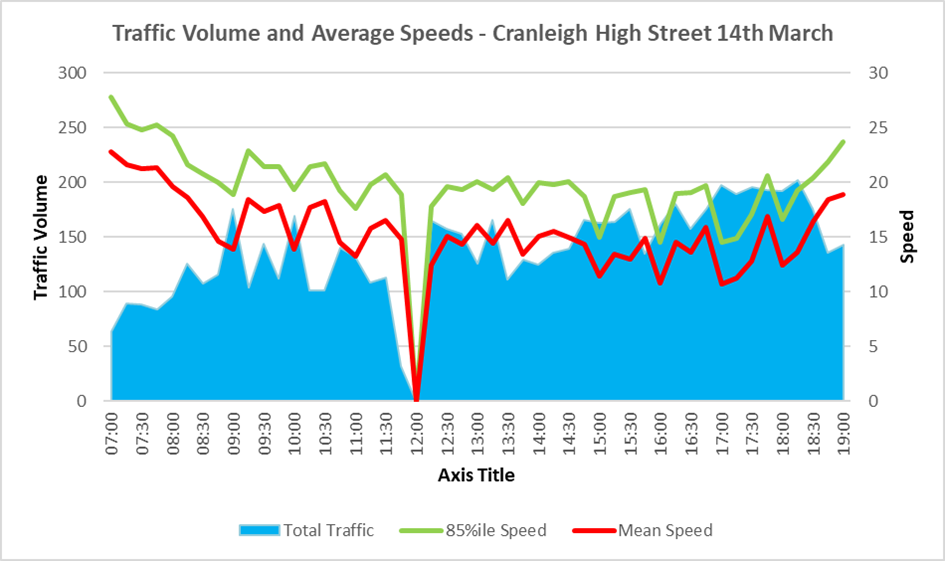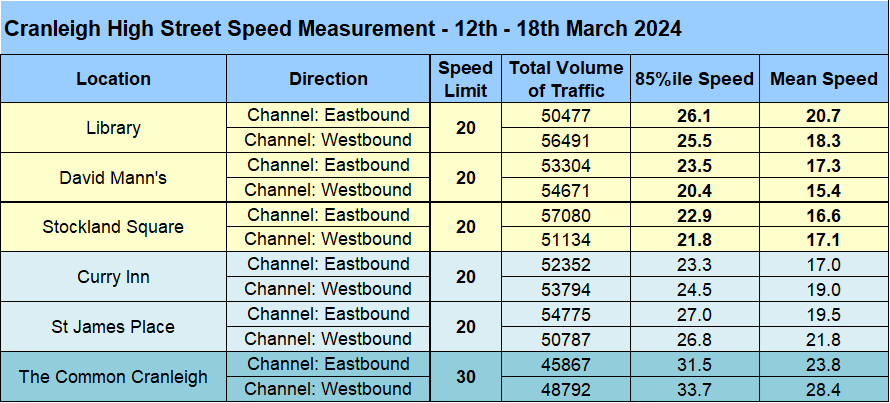Cranleigh traffic survey results
We have written this section in response to the claim made in the letter that Surrey County Council ('SCC') sent to Cranleigh residents in early May.
In this letter it was stated that “a speed survey found that even at the busiest times of the day vehicles regularly travel along the High Street faster than the 20mph limit.”
This claim does not reflect the reality experienced by many residents and visitors to Cranleigh.
A traffic study was undertaken by SCC in March 2024. We have obtained the results of this study and our interpretation is that there is no traffic speeding issue in Cranleigh. The analysis is presented below and is quite complex. But it is abundantly clear that traffic speed is not an issue that we should be concerned about as we plan for High St changes. This is consistent with the views of the vast majority of residents and businesses in Cranleigh that we have had conversations with. Indeed, it would not be unfair to use the well-known expression “You cannot be serious!” as the reaction of most people when asked if Cranleigh has a speeding problem.
DETAILED ANALYSIS
The Save the Heart of Cranleigh team submitted a Freedom of Information request to SCC in April and was provided with all of the data from 6 measuring points in Cranleigh. In order to avoid bombarding readers with tons of data, we have focused attention on the data from the centre of the Village.
Traffic was measured Eastbound i.e. from the Common to the Library and also in the opposite direction. Data was collected in 15-minute intervals throughout the day and the type of vehicle was also identified. In analysing speed, a mean or average speed was calculated for each 15-minute slot throughout the day. In addition to this SCC calculated an 85 percentile measure.
The mean average speed is a simple addition of all the speeds of vehicles in a 15-minute time period, divided by the total number of vehicles. So, what is the 85percentile measure? The 85th percentile is often used to determine speed limits for roads. The theory assumes that most drivers are reasonable and do not want to get in an accident but do want to get to their destination as quickly as possible. Therefore, a speed at which 85 percent of people drive is figured to be the highest safe speed for that road. (source Science.com)
The chart below shows the difference between straight average and this 85 percentile on Thursday 14th March in the centre of the High Street. It also shows the volume of vehicles measured every 15 minutes across the period 7am to 7pm. As can be seen around midday traffic came to a complete halt, something we all frequently experience in Cranleigh.
Because of the way it is calculated the 85 percentile will always show a higher number than the straight average, however the 85 percentile line is still at or below 20mph from 8am to 6pm and is below 25mph from 7:30am to 8am and after 6:30pm. The straight average speed is well below the 20mph limit, with the exception of the period from 7:00am to 7:30am.

The table below shows the 85 percentile and mean (straight average), calculated at each of the 6 measuring sites throughout the High Street, separating eastbound and westbound traffic. SCC announced at the first Stakeholder Group meeting, that the scope of the High Street project had been reduced to just cover the section from Stockland Square to the Library. (We have challenged this because up to that point it was clear that the project covered the entire High Street from Horseshoe Lane junction to the Obelisk Junction.)
The three measuring points highlighted in blue, in the table below, are currently out of scope of the project, so it is the Library, David Mann’s and Stocklund Square measure points that are relevant.

Of the remaining three places it can clearly be seen that there is no case for speed reduction measures in the centre of the Village - as average speeds are well below the 20mph limit, and even the 85 percentile measure is only fractionally above the limit. These measures include all vehicles across 24 hours over a 7-day period, including Sunday when average speeds are higher as traffic is generally much lighter.
The table below shows the 85 percentile speeds for the three locations in scope, for the period 7am to 7pm over the 7 days it was measured, as can be seen there is absolutely no speed issue - as all the 85 percentile measures in the centre of the Village are at or below 20mph. Speeds measured at the Library are slightly higher reflecting the fact that drivers are just leaving or entering the 20mph zone. Given this 85 percentile measure is used to set safe speed limits, it is clear that Cranleigh High Street does not require any interventions to reduce traffic speed.

Conclusion
We think you can clearly see that whichever way you look at the data, Cranleigh does not have a traffic speed problem but a volume of traffic problem. The data above shows that well over 100,000 vehicles a week are travelling through the Village.
These results are consistent with the SCC Feasibility Report on the introduction of the 20mph speed limit published in Oct 2021. In this report written by T.Cox it states:
The speed data shows the mean speeds on High Street are between 18mph and 24mph depending on location and direction.
It is recommended that imposing a 20mph speed limit along High Street will not significantly lower average speeds as the recorded average speeds are already low.
However, it is something which can be done quickly and relatively inexpensively if the committee decide to peruse this option.
Based on the County Council’s speed limit policy, the recorded speeds suggest that the speed limit can be lowered to 20mph using signs alone without supporting engineering measures.’
The results are also consistent with SCC’s own traffic modelling team - who reported on average speeds along the High Street when looking at the Village Way junction. In their report published in August 2022, they stated.
Observed journey time indicated that for AM and PM peak hours tested, average speeds were actually found to be below 20mph on virtually every part of the network regardless of the direction of travel.
Why is this important, well the previous designs from the Placemaking Team were heavily focused on traffic calming measures such as:
- Raised traffic platforms.
- Narrowing the High Street.
- Narrowing bus laybys – resulting in buses obstructing traffic flow.
Despite the results of this survey, SCC are still convinced that there is a speed problem in Cranleigh - as evidenced by the minutes of the first stakeholder group meeting.